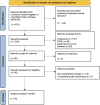Suction use in ureterorenoscopy: A systematic review and meta-analysis of comparative studies
- PMID: 39416755
- PMCID: PMC11479806
- DOI: 10.1002/bco2.408
Suction use in ureterorenoscopy: A systematic review and meta-analysis of comparative studies
Erratum in
-
Erratum.BJUI Compass. 2024 Dec 30;5(12):1324-1329. doi: 10.1002/bco2.482. eCollection 2024 Dec. BJUI Compass. 2024. PMID: 39744071 Free PMC article.
Abstract
Objectives: Ureterorenoscopy is seeing a bloom of technological advances, one of which is incorporating suction. The objective of this study is to systematically review existing literature regarding suction use in rigid and flexible ureterorenoscopy and perform meta-analysis of studies comparing suction versus no suction ureteroscopy or mini percutaneous nephrolithotomy (PCNL).
Methods: A literature search was performed (November 2023) in MEDLINE, Embase and Cochrane CENTRAL. Study protocol was registered at PROSPERO (CRD42023482360). Comparative studies (observational and randomized) were eligible for inclusion if they compared suction versus no suction group and reported at least one primary outcome of interest (stone-free or complication rate).
Results: Sixteen studies (5 randomized and 11 observational), analysing 1086 and 1109 patients in standard and suction groups, respectively, were included. Final stone-free rates (SFRs), overall and infectious complications and length of hospital stay exhibited significant improvement when suction was used. When mini-PCNL was compared with flexible ureterorenoscopy with suction, no differences were found in terms of stone-free and infectious complications rates.
Conclusions: Ureterorenoscopy is a commonly performed endoscopic procedure for urolithiasis treatment, the success of which is defined by SFRs and complication rates. Application of suction via ureteral access sheaths, ureteral catheters or scopes may provide improved SFRs, reduced overall and infectious complication rates, along with a reduction in length of hospital stay. Further randomized studies are needed to validate these findings and standardize indications and protocols.
Keywords: endourology; retrograde intrarenal surgery (RIRS); suction; ureteroscopy (URS); urolithiasis.
© 2024 The Author(s). BJUI Compass published by John Wiley & Sons Ltd on behalf of BJU International Company.
Conflict of interest statement
L. Tzelves is an associate member of EAU Guidelines Panel on Urolithiasis, a YAU Member in Endourology Group and a member of ESU Working Group on PCNL. R. Geraghty is an associate member of EAU Guidelines Panel on Urolithiasis. P. Juliebø‐Jones is a YAU Member in Endourology Group. Y. Yuan is a member of EAU Guidelines Methods Office. G. Vineet is a clinical and education research consultant for PUSEN, BIORAD, CLEARPETRA, INNOVEX, ROCAMED and BD and a member of European Section of Urolithiasis (EULIS), EAU Guidelines Dissemination committee; a board member of endourology academy; and a board member of kidney stone academy. A. Skolarikos is a member of EAU Guidelines panel on Urolithiasis and European Section of Urolithiasis (EULIS). B. Somani is a member of EAU Guidelines panel on Urolithiasis and European Section of Urolithiasis (EULIS).
Figures
References
-
- Tzelves L, Somani B, Berdempes M, Markopoulos T, Skolarikos A. Basic and advanced technological evolution of laser lithotripsy over the past decade: an educational review by the European Society of Urotechnology Section of the European Association of Urology. Turk J Urol. 2021;47(3):183–192. 10.5152/tud.2021.21030 - DOI - PMC - PubMed
-
- Gauhar V, Chew BH, Traxer O, Tailly T, Emiliani E, Inoue T, et al. Indications, preferences, global practice patterns and outcomes in retrograde intrarenal surgery (RIRS) for renal stones in adults: results from a multicenter database of 6669 patients of the global FLEXible ureteroscopy Outcomes Registry (FLEXOR). World J Urol. 2023;41(2):567–574. 10.1007/s00345-022-04257-z - DOI - PubMed
Publication types
LinkOut - more resources
Full Text Sources


